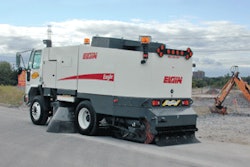If anyone knows the intricacies of the 410-lane-mile municipal street system in Syracuse, NY, it’s Phil Wright, superintendent of the Department of Public Works’ Bureau of Street Repair. The 35-year street veteran is in charge of managing an annual $5.5-million budget and a crew of 45.
Syracuse’s Bureau of Street Repair is responsible for patching potholes and road reconstruction, which includes milling old asphalt, producing and placing new hot mix asphalt, preserving good streets, and installing (through a subcontractor) granite curbing (which holds up better to the heavy plow action required to clear the streets of 125-plus inches of snow each winter).
From April 1 to November 15, Wright’s crew is busy reconstructing streets and from November 15 to April 1, they’re busy plowing snow. Syracuse has two classifications of streets — improved and unimproved. Improved streets have curbing, while unimproved streets don’t. Unimproved streets, which account for approximate one-third of city’s streets, are generally maintained with slurry seal applications, or in some cases a one inch hot mix asphalt (HMA) overlay. Wright uses a subcontractor for all slurry seal work and schedules applications on a rotating three-year basis.
For all improved (curbed) streets, the city uses the Army Corp of Engineers’ rating system along with core samples to monitor conditions and determine which streets require reconstruction.
Managing the system
The Bureau of Street Repair has divided its street responsibilities into four quadrants, with 10 percent of the roadways designated as heavily-traveled streets. This helps to ensure all areas of the city, particularly heavily-traveled streets, are being addressed when scheduling work for the coming year.
“We have 25 years of rating records we use to prioritize street repairs,” Wright says. “We still have some streets with a #4 or #5 rating (requiring a mill and fill reconstruction approach), but in another three to four years we hope to have all our streets in a #6, #7 or #8 rating (good condition).”
The challenge
Unlike a high production road project that can move along at a fairly good clip, city street paving has its own set of unique challenges. Working in residential or retail areas where traffic restrictions are required during the course of the project and having to work around utility access in the street are the two distinct challenges Wright’s crews deal with on a daily basis.
“We not only have the manhole covers and other utility access points to work around, we also have to be careful on how we compact the new asphalt we’re putting down,” Wright says. “Some of the water mains in the city are over 100 years old, so we have to be careful when operating our rollers in a vibratory mode and not cause damage to the utilities under the road. The paving crews will use vibratory compaction in the breakdown rolling pattern, but not aggressively. Final compaction is achieved with rollers operating in static mode.”
To keep projects on schedule, Wright outfits one milling crew and one main paving crew. If the milling crew is ahead of its schedule, Wright will then use them as a second paving crew to get caught up with the streets that have been milled. His department maintains an Ingersoll-Rand milling machine and leases a Marini milling machine as well. For cleanup and tight areas, the milling crew uses a Bobcat with a milling attachment. For paving, The Bureau of Street Repair has a Barber Greene paver, leases a Blaw Knox, and several Ingersoll-Rand rollers. Wright estimates his department spends approximately $250,000 a year on equipment, but that expenditure is covered by a capital equipment budget and not the road reconstruction budget.
Mill and fill
Typically, a project is milled one day and paved the next. Most day-long paving jobs require 650 to 700 tons, with some requiring up to 2,000 tons.
The paving crew is supplied by the department’s own Barber Greene parallel-flow drum plant, which produces approximately 52,000 tons of HMA annually. The department also purchases another 10,000 to 15,000 tons from an independent producer.
The Syracuse street department’s HMA plant produces a basic Marshall Mix, which seems to work best for the drainage and the climatic conditions the streets are exposed to. All binder course mixes used in mill and fill applications consists of ½- to ¾-inch nominal size aggregate and 5.6 percent asphalt cement binder, with 30 percent reclaimed asphalt pavement (RAP) content.
Some of the milled asphalt, like sheet asphalt (sand and asphalt binder) which was commonly used in Syracuse at one time, can’t be used as a RAP additive because it lacks aggregate and produces a high blue smoke emission when added to a mix. As for the surface course applied on Syracuse street projects, the plant produces a similar Marshall Mix with ¼-inch nominal aggregate size.
“It cost us $28 per ton to produce the mix we need and under a government contract with an independent producer it would cost us $32 to $33 per ton,” Wright says. “So, we not only save quite a bit by producing our own mix, we’re also able to easily adjust to what our paving crews need. If we have a lot of utility work that slows us down, we can make that adjustment at our plant instead of telling an independent producer what we think we may or may not need on any given day.”
The savings and control the HMA plant provides Wright’s street department is such a significant benefit that The Bureau of Street Repair is in the process of researching the purchase of a new plant. Currently, the street department is looking at replacing its current 120-tph plant and 50-ton storage silo with a 250-tph plant and two 100-ton silo system.
“I don’t know many municipalities that own their own asphalt plant, and I’m sure many of them contract out much of their paving to independents, but for us this has been a very successful approach to building and maintaining a good road system throughout the community,” Wright says. “We’ve done it this way for as long as I’ve been here. We can keep our street crews busy year-round by having them plow snow in the winter and reconstruct streets during the summer. It’s nice to have the same experienced paving crew ready to go at the beginning of the paving season.”


![Lee Boy Facility 2025 17 Use[16]](https://img.forconstructionpros.com/mindful/acbm/workspaces/default/uploads/2025/09/leeboy-facility-2025-17-use16.AbONDzEzbV.jpg?auto=format%2Ccompress&fit=crop&h=100&q=70&w=100)








![Lee Boy Facility 2025 17 Use[16]](https://img.forconstructionpros.com/mindful/acbm/workspaces/default/uploads/2025/09/leeboy-facility-2025-17-use16.AbONDzEzbV.jpg?ar=16%3A9&auto=format%2Ccompress&fit=crop&h=135&q=70&w=240)








